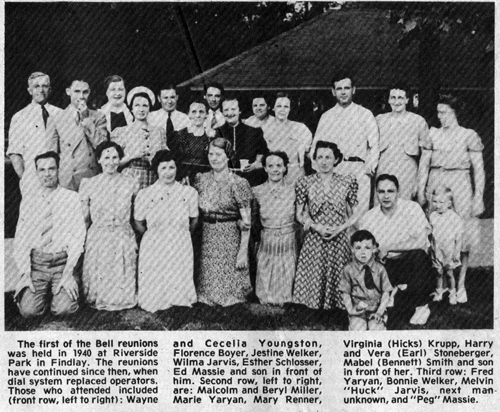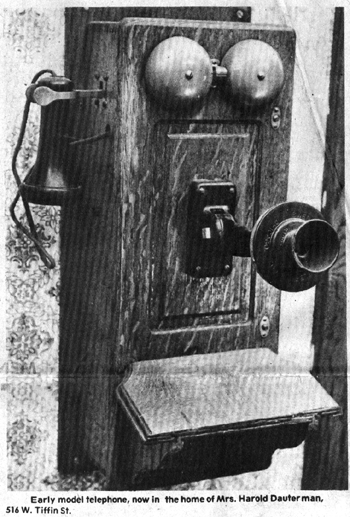March 3, 1983


Picture #1 – The first of the Bell reunions was held in 1940 at Riverside Park in Findlay. The reunions have continued since then, when dial system replaced operators. Those who attended included (front row, left to right): Wayne and Cecelia Youngston, Florence Boyer, Jestine Welker, Wilma Jarvis, Esther Scholsser, Ed Massie and son in front of him. Second row, left to right: Malcolm and Beryl Miller, Marie Yaryan, Mary Renner, Virginia (Hicks) Krupp, Harry and Vera (Earl) Stoneberger, Mabel (Bennett) Smith and son in front of her. Third row: Fred Yaryan, Bonnie Welker, Melvin “Huck” Jarvis, next man unknown, and “Peg” Massie
Picture #2 – Early model telephone, now in the home of Mrs. Harold Dauterman, 516 W. Tiffin Street.
Author’s Note: This is the third and last in the series about the history of the telephone along with the people who implemented it in Fostoria.
Surprised is not quite the word to express my reactions when Jim Brandt on a tour of Ohio Bell’s central office in Fostoria, pointed out a device about four feet high and perhaps two feet square and said, “That’s the time- temperature machine”.
All the years I had called 435-0811 to see how hot or cold it was outside or the correct time, I never knew that the information was coming from a gadget at Bell’s central office in Fostoria.
Every minute of the day or night, that invisible man is on duty providing the time and temperature. And twice a year the machine must be reset for the change in time – spring ahead in the spring and fall back in the fall. If some type of malfunction should occur in the machine, a technician must fly from Atlanta.
Many hair raising stories have been told and written which pertain to the telephone, but I was told one I had never heard before. It happened the day the Dillinger gang robbed the First National Bank here.
The ground floor door to the second floor of the Ohio Bell offices at 117 E. North St. where the operators worked at the switchboard, was controlled from upstairs. Authorized personnel signaled for entry by pressing a buzzer according to code: one long and one short ring. Upstairs the door was unlocked by an electric switch, but only after looking out the window to make sure the person was permitted access.
Sometime before the Dillinger gang descended on the bank, the operators upstairs heard someone pounding on the entrance door. Bonnie Welker said she went to the window and asked what was wanted. There were two men downstairs. One replied they were inspectors and needed to check the equipment, but Bonnie knew better than that. She told them everything was OK. The men persisted in their need to enter.
The operators upstairs, by that time, were busy placing calls, seeking assistance from police and sheriff’s departments in other towns, and consequently didn’t have time to alert anyone locally about the two men trying to gain access.
When the men saw that they were bilked in their attempt to gain entrance, they left.
To this day, Bonnie and other operators who were on duty believe the men were accomplices of the Dillinger gang, wanting to gain entrance to disrupt the outgoing calls for help. However, since none of the men were captured, the story is only suspicion.
DEPRESSION DAYS FOR PHONE PEOPLE
Mrs. Eddie (Peg) Massie, former Fostorian now living in Florida, remembers the 1931 Depression days and how it affected the telephone business. She tells the story:
“Companies were cutting hours and laying off workers. It was really rough. Telephones were being taken out. People were cutting expenses everywhere they could.”
“Our telephone company put three traffic departments employees, along with plant employees on the job of canvassing the city to bolster business. We reviewed with each one visited their service and suggested additional service and discouraged disconnecting their service. We also watched for new customers.”
“toledo, being our headquarters, a broadcasting network was set up between Toledo, Sandusky, Findlay, Tiffin and Fremont. Each morning we went to the lounge to hear our pep talk from Toledo before going out. If we had a good day in sales, our town got to put on the program.”
“Jim Dawson in Fostoria office was always tops. He and Mellon sold the Hays Hotel room service, and in depressed days that was a big deal.”
“By putting three operators out to call on subscribers, that gave more hours to others and plant men were helping their co-workers too. Helen Turner, Jestine Welker and I were the operator team”.
EARLY MODEL TELEPHONE
If all of the old local Ohio Bell employees were together they probably could spin many interesting yarns about the old days.
Perhaps talk about the early phone models used during the early days after the invention of it, as illustrated in the accompanying photo taken recently in the home of Mrs. Harold Dauterman, 516 W. Tiffin Street.
the phone was actually in service in Fostoria during that early period. When they were replaced by more modern equipment, many were salvaged as relics as was this one by Mr. and Mrs. John Bowman, daughter and son-in-law of Mrs. Dauterman.
Not shown in the photo is a small hand crank on the right side, which when turned sent an electric impulse through the line to the operator who answered and connected the caller with the desired person.
Back then, several subscribers were often on one line and supposedly answered only when their telephone rang their particular ring, but that didn’t keep neighbors from listening in on each other’s phone calls.
The telephone bells are at the top of the box. The mouthpiece which projected from the front was adjustable to accommodate the various heights.
CORPORATE CHANGE IN PHONE BUSINESS
Since this article was started, Ohio Bell had undergone changes in its corporate structure coming from orders by the Federal Communications Commission.
One of the effects of these orders relates to the rental and sales of telephones by Ohio Bell, which in turn relates to installation. It isn’t quite as simple as in the past. When a new customer signed up and the phone was installed by Bell, if something went wrong with the phone itself, a Bell repairman came and fixed it. It is not as simple as that anymore.
Some of the other changes which have come about as a result of the new regulations and affect Ohio Bell’s customer relations have been published by various media, but the simplest answer for customers is to dial 1-800-555-5000 – that’s the “Let’s Talk” number setup by Ohio Bell as a customer information line.
The telephone itself and the expanded uses of it today would probably surprise Alexander Graham Bell and Thomas Edison too. It has become indispensable in the home, business, schools, industry and government, and more innovations are just around the corner.
PEOPLE AND HOUSES ON CROCKER STREET
Author’s Note: Today ends Esther Shaffer’s reminiscing about Crocker Street, except for a few corrections which will be presented later. The series had produced enthusiastic response from readers.
NO. 244 – This property belonged to R.A. Boyer, then later a family named Heffelfinger lived there. Carl and Cleo (Reiss) Herbert bought it in about 1915. Their children were Dale who was an outstanding athlete at Bowling Green and later a coach there, and Mary Elizabeth who played the piano for Fostoria groups. The Herberts lived there until Mr. Herbert’s death and Mrs. Herbert was no longer able to live alone. It was then sold to Miss Lynn Jones.
NO. 248 – Hal Stout’s parents owned this property. Hal was a star football player on Coach L.C. Boles team during the early years at F.H.S. Later, Hal was city editor at the Fostoria Review. The property rental property for many years and then sold to the Andrews family. Mr. Andrews died shortly after they moved there, but Mrs. Andrews continued to live there for many years. Her son Earl, also known as “Happy” was one of the big band era musicians. His bands played the Atlantic City Boardwalk, Pittsburg hotels and throughout the South. He helped local young musicians especially Guy Workman, Richard Conley and Lola Lutzy. Both a piano player and vocalist. Andrew’s band was very popular. The band often practiced at his home and the neighborhood enjoyed the music. He was stand-by pianist for Zez Confrey’s band too. Confrey, composer of “Dizzy Fingers” and “kitten on the Keys”, played the specialities, leaving the routine for “Happy” while he led the band. It was a great compliment for Andrews to work with Confrey. The Andrews sold the property to Mr. and Mrs. Ralph Brant who sold to Mr. and Mrs. Lynn Echelberry.
NO. 258 – Mrs. Edna Wise, her daughter Florence, and son Harold, lived there for many years. The property was owned by the Cadwallader family. Florence grew up in Fostoria, graduated from FHS and later held a responsible job with the State of Ohio. She married Ralph Brant and they live on Roosevelt Drive.